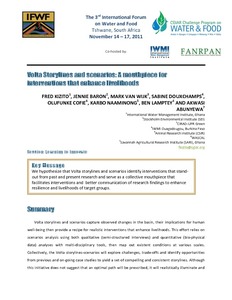Water and poverty in two Colombian watersheds
Watersheds, especially in the developing world, are increasingly being managed for both environmental conservation and poverty alleviation. How complementary are these objectives? In the context of a watershed, the actual and potential linkages between land and water management and poverty are complex and likely to be very site specific and scale dependent. This study analyses the importance of watershed resources in the livelihoods of the poor in two watersheds in the Colombian Andes.
Water investment domains for sustainable agricultural development in the Blue Nile basin
In the Blue Nile basin, crop cultivation is predominantly rainfed and water availability is highly variable across both space and time. As a result, it often constitutes a limiting factor for reaching full agricultural potential in the region. While one third of the basin is estimated to have no soil moisture limitations, the remaining two thirds are crop water constrained in various ways. Analysis shows that across approximately 40% of the basin available soil moisture is utilized sub-optimally with smart management and crop water limitations can be alleviated.
Vertical asymmetries and collective action in watershed management
Water acid modeling for effective water management: A case study in Ca Mau peninsula Mekong Delta Vietnam
Water conservancy projects in China
Wasted food, lost water: ethical imperatives for water conservation
Water and poverty linkages: case studies from Nepal, Pakistan and Sri Lanka. Project report 1
The case studies reported here highlight important concepts and information on the linkages between water and poverty that may not be available elsewhere. The overall objective of the studies is to draw generic lessons and identify interventions that can help policy makers, planners and other stakeholders to develop actions that are effective in water resources management for the poor. All case studies focus on poor in South Asia, but all with differing geographic contexts or thematic focci. The first two papers are based on field surveys supplemented by literature reviews.



